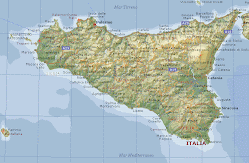
There is a chestnut in a small village
called Saint Alfio at the foot of volcano
Etna which seems to be the biggest and the most ancient tree in Europe (between 2000 and 4000 years old).
It can be considered a real "vegetal monument" and it attaracts lots of tourists every year.
Its story was told by Jean Houl who after a visit in S. Alfio was so impressed that he wrote about it.
There is a fascinating legend linked to this marvellous tree that tells us that queen Giovanna d'Aragona used to go to Naples and then to Sicily to visit volcano Etna together with the nobles from Catania riding a horse like her knights.
It seems that one day she with all her knights was caught in the storm, so she took refuge under the huge tree whose leaves became a very safe shelter for all of them.
Today the tree is divided into three hollowed trunks. In the past there was a house inside it.












